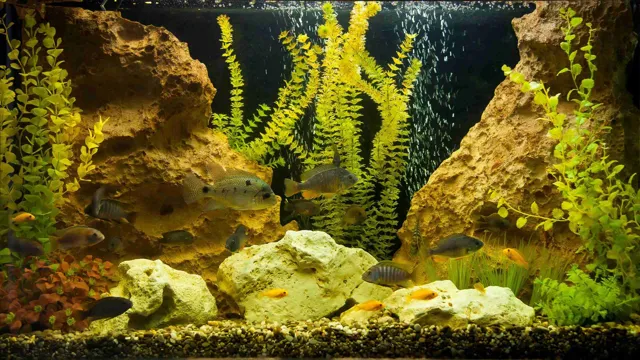Are you a fish enthusiast looking to set up your aquarium? If so, you know that there are many important factors to consider when it comes to keeping your fish safe and healthy. You may be aware of some of the most common things to look out for, such as water quality and temperature control. However, one crucial aspect of aquarium safety that is often overlooked is rock safety.
Many aquarium owners use rocks to create a natural-looking environment for their fish, but not all rocks are created equal. Some rocks may contain harmful materials that can leach into the water and harm your fish. Additionally, rocks that are not properly secured can shift or fall over time, potentially causing damage to your aquarium or injuring your fish.
Ensuring rock safety for your aquarium is essential for the well-being of your aquatic pets. There are several steps you can take to make sure your rocks are safe for your aquarium environment. Before adding any rocks to your tank, do your research to ensure that they are safe for use in an aquarium.
You can also take steps such as securely anchoring your rocks to prevent shifting or falling. By taking the time to carefully consider the rocks you use in your aquarium and implementing proper safety measures, you can create a safe and healthy environment for your fish to thrive. So the next time you’re setting up your aquarium, make sure to put rock safety at the top of your priority list.
Understanding the Importance of Safe Rocks
When it comes to creating a beautiful and healthy aquarium environment, it’s important to choose the right rocks for your tank. Not all rocks are safe for aquariums, as some can alter the water chemistry and harm aquatic life. So how can you make sure the rocks you choose are safe? Start by doing your research and choosing rocks that are known to be aquarium-friendly, such as quartz, granite, and lava rock.
Next, clean the rocks thoroughly to remove any dirt or debris that could pollute the tank. To be extra cautious, you can soak the rocks in a solution of 1 cup bleach to 5 gallons of water, rinsing them thoroughly afterward. Finally, test the pH and hardness levels in your tank to make sure the rocks aren’t impacting the water chemistry.
By following these steps, you can ensure that your aquarium rocks are safe and won’t harm your fish or other aquatic creatures.
Potential Dangers
As you explore the great outdoors and climb rocks for a thrilling experience, it’s crucial to understand the importance of safe rocks. Even though it may seem like an exciting adventure, there are potential dangers that you need to be aware of. One of the most significant risks is falling off the rocks, which can result in serious injuries or even fatalities.
It’s essential to ensure that the rocks you are climbing are stable and secure before you begin your ascent. You should also make sure you have the right gear, such as helmets, harnesses, and climbing shoes, to maximize your safety. It’s also worth noting that weather conditions can play a significant role in the safety of the rocks, so be prepared and informed before you embark on your climbing journey.
Remember, safe rocks equal a safe and enjoyable experience, so don’t take any shortcuts when it comes to your well-being.

Benefits of Safe Rocks
Safe rocks are an essential part of any construction project, and their importance cannot be overstated. When rocks are not handled properly, they can lead to accidents and injuries on the worksite. However, with safe rocks, workers can focus on their jobs without worrying about potential hazards.
Not only do safe rocks increase safety, but they also improve overall productivity. By ensuring that rocks are safe to handle, workers can perform their tasks faster and more efficiently. Additionally, safe rocks reduce the risk of damage to equipment and structures, which can lead to costly repairs. (See Also: How to Put Black Background on Aquarium and Transform Your Fish Tank in Minutes)
Overall, understanding the importance of safe rocks is crucial for any construction project, and organizations should prioritize their use for the safety and success of their operations.
Choosing the Right Rocks
When it comes to choosing the right rocks for your aquarium, safety should always come first. Before purchasing any rocks, it’s essential to make sure they are safe for your fish and other aquatic animals. One crucial factor to consider is the type of rock.
Some rocks, like limestone and dolomite, can raise the pH levels in your water and potentially harm your fish. On the other hand, rocks like quartz and granite are typically considered safe for aquarium use. Another important consideration is the texture and shape of the rock.
Sharp edges and rough surfaces can damage your fish’s delicate fins and skin, so it’s best to choose smooth, rounded rocks. It’s also crucial to thoroughly clean and sterilize any rocks before adding them to your aquarium to prevent the introduction of harmful bacteria or parasites. By taking the time to carefully choose safe, aquarium-friendly rocks, you can create a beautiful and healthy environment for your aquatic pets to thrive.
Non-Toxicity
When it comes to choosing rocks for your aquarium, non-toxicity should be a top priority. You want to make sure that the rocks you add to your tank won’t harm your aquatic friends. One way to ensure non-toxicity is to choose rocks that are specifically marketed for aquariums.
These rocks are typically tested and approved for use in aquatic environments. Additionally, avoid rocks that may leach harmful chemicals or heavy metals, such as limestone or other soft rocks. It’s always better to err on the side of caution and do your research before adding any rocks to your tank.
Remember, a little extra effort in choosing the right rocks can go a long way in keeping your aquatic inhabitants healthy and thriving.
Rock Type
Choosing the right rocks for your project can be a daunting task, but it is essential for its success. The rock type you select will ultimately depend on your location, the purpose of your project, and personal preference. The three main types of rocks used for landscaping purposes are sedimentary, igneous, and metamorphic.
Sedimentary rocks are great for creating natural-looking landscapes due to their weathered appearance, while igneous rocks are great for creating a dramatic effect due to their intense colors and patterns. Metamorphic rocks, on the other hand, are perfect for projects that require durability and strength, such as building retaining walls and walkways. It’s important to consider the properties of each rock type before making a decision to ensure it’s suitable for your project’s needs.
By doing so, you’ll create a stunning landscape that not only looks great but also meets your requirements. So, take your time, do some research, and choose the right rocks for your project!
Size and Shape
When it comes to choosing rocks for your landscaping project, the size and shape of the rocks are important factors to consider. You’ll want to choose rocks that fit well with the overall design aesthetic you’re trying to achieve, as well as the size of your space. For example, large rocks can make a small yard look cluttered, while small rocks might get lost in a larger space.
You’ll also want to consider the shape of the rocks- round rocks can give a more natural, organic feel, while angular rocks can create a more modern look. Ultimately, the size and shape of your landscaping rocks should be chosen based on the overall design vision you have for your outdoor space. By taking the time to carefully consider these factors, you’ll be able to select the perfect rocks to enhance your home’s curb appeal. (See Also: How to Get Expo Marker Stains off an Aquarium: Easy and Effective Techniques)
Porosity
When it comes to choosing rocks for your project, it’s important to consider their porosity. Porosity refers to the amount of space or voids within a material, and it can affect how easy it is for water and other substances to penetrate the rock. Rocks with low porosity, such as granite, are ideal for outdoor projects since they’re less likely to absorb water and freeze, which can cause cracks and damage over time.
On the other hand, highly porous rocks like sandstone and limestone can be more easily eroded by rainfall and wind over time. To ensure that you choose the right rocks for your specific project, it’s important to consider the porosity and other characteristics of each type of rock before making your choice. That way, you can select the best material for your needs and ensure that your project will last for years to come.
Preparation
When adding rocks to your aquarium, it is important to prepare them properly to ensure they are safe for your aquatic pets. First, it is essential to clean the rocks thoroughly by scrubbing them with warm water and a brush to remove any dirt or debris. Avoid using any chemicals or harsh cleaners as this could be harmful to your fish.
Once the rocks are clean, you will want to test them for their mineral composition and pH levels. A simple vinegar test can be performed by placing a few drops of vinegar on the rocks and observing any reactivity. If the rocks fizz or bubble, this could indicate a high mineral content that could be harmful to your fish.
Additionally, make sure the pH levels of the rocks match the pH levels of your aquarium to avoid any fluctuations that could be detrimental to your aquatic pets. By taking these simple precautions, you can ensure that your aquarium rocks are safe and will not harm the delicate ecosystem of your tank.
Cleaning
When it comes to cleaning, preparation is key to ensuring a successful and efficient cleaning process. Before starting any cleaning task, it’s important to first assess the area that needs to be cleaned. This can include identifying any areas that may require extra attention or may need special cleaning supplies.
Next, make sure that all necessary cleaning supplies are within easy reach. This can include things like cleaning solutions, rags, sponges, and gloves. It’s also important to make sure that the area is clear of any clutter or obstacles that may make cleaning more difficult.
Taking the time to properly prepare before starting a cleaning task can save time and reduce the stress of the cleaning process. So, before diving in, take a few minutes to assess and prepare the area for a successful cleaning experience.
Quarantining
With the recent outbreak of COVID-19, it has become critical to prepare for a potential quarantine. Depending on where you live, quarantining could mean being stuck inside for days, weeks, or even longer. The first step to being prepared is to stock up on essentials like food, water, and medicine.
It’s also important to have a plan in place for communicating with loved ones and staying entertained while indoors. While it may seem daunting, taking the time to prepare now could make all the difference in the event of a quarantine. Don’t wait until the last minute – start getting ready today.
Conclusion
In the world of aquariums, safety always comes first. When it comes to using rocks in your tank, it’s important to take a few extra steps to ensure that both your fish and your rocks are in top form. From washing and scrubbing, to testing for pH levels and potential toxins, the key to keeping your underwater world rock-solid is all in the preparation. (See Also: How to Make Your Aquarium Plants Grow Faster: Tips and Tricks for Optimal Growth)
So remember, don’t rock the boat – just follow these simple steps and let your fish swim safely amongst the stones.”
FAQs
How do you test if rocks are safe for an aquarium?
One way to test if rocks are safe for an aquarium is by pouring vinegar on them. If the rock fizzes, it may affect the pH levels in your aquarium and should not be used.
Can any type of rock be used in an aquarium?
No, not all rocks can be used in an aquarium. Some rocks may contain harmful minerals or metals that can have adverse effects on the water chemistry and the aquatic life.
How long should rocks be soaked before placing them in an aquarium?
It is recommended to soak rocks for at least two weeks before placing them in the aquarium. This allows any harmful substances to leach out.
Can boiled rocks be used in an aquarium?
Boiling rocks is not recommended as it can cause them to explode. Additionally, boiling does not necessarily remove all harmful substances.
How often should rocks be cleaned in an aquarium?
Rocks should be cleaned at least once a month to remove any algae or debris that may accumulate on them.
Are painted rocks safe for use in an aquarium?
Painted rocks should not be used in an aquarium as the paint can chip off and contaminate the water, harming the aquatic life.
How do you sterilize rocks for an aquarium?
One way to sterilize rocks for an aquarium is by boiling them in water for at least 30 minutes. Another way is to soak them in a solution of bleach and water (1:10 ratio) for 24 hours, and then rinse them thoroughly before use.







